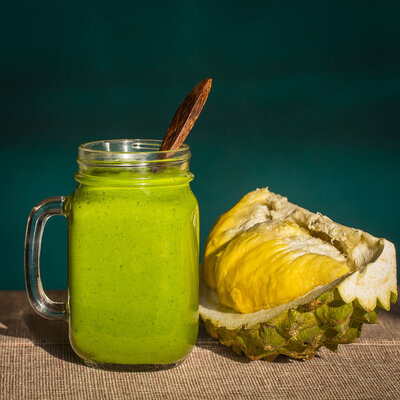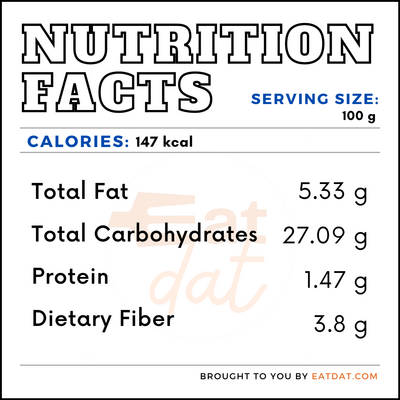
Durian Juice
What is Durian Juice?
Durian juice is the liquid extract of the durian fruit. Found in Asian countries, this fruit is large and contains many edible fleshy segments inside its spiny shell. Although it is a popular fruit in Asia, durian fruit has a strong, bad smell that may influence its flavor.
- Generally, the juice has a bittersweet taste but is well-accompanied by other fruit juices, such as banana, starfruit and passion fruit.
- Durian juice is a common natural remedy in Traditional Chinese Medicine for its many health benefits.
The some common varieties of durian are:
- Musang King (comes with a smooth, bright, and very buttery flesh)
- Sultan Durian (has a bittersweet taste and golden flesh)
- Black Pearl (slightly bitter taste with smooth flesh)
- Red Pawn (sticky but smooth flesh)
- Green Bamboo (comes with harder flesh, when compared with other varieties)
- Golden Phoenix (has a stronger flesh and bittersweet taste)
Origin of durian juice
This fruit is native to Borneo and Sumatra, and can be found in lower Burma and South Tenasserim. For nearly 400 years, lower Burma and Upper Burma traded the durian between them. Cultivation of this fruit also takes place in countries like India, Ceylon, and New Guinea. Since 1959, durian has been produced and exported in Thailand and South Vietnam. However, durian is not available in other regions, and is found in limited quantities in the Southern Philippines, particularly in Mindanao and Sulu. Today, this fruit is shipped worldwide for use in many dishes, including this fruit juice.
Nutrition
A 100g of durian juice contains:

Durian is rich in minerals, including copper, magnesium, manganese, potassium, and phosphorus. Not to mention, it is rich in vitamins A and C, as well as in B vitamins, such as vitamin B6, niacin, folate, pantothenic acid, and riboflavin. Additionally, this high-energy fruit is rich in good fats, and volatile compounds such as esters, thioacetals, thioesters, flavonoids, thiolanes, ascorbic acids, and carotenoids. Regular consumption of this fruit is believed to help in controlling blood sugar levels, due to its potassium content. Additionally, durian juice may help lower cholesterol.
Commercial production
Durian juice is produced like every other fruit juice. First, the flesh is carefully removed from the shell using a machine. Then, the flesh is placed in a juicer where it is properly pressed to extract the juice content in the flesh. Afterward, it undergoes a series of sterilization processes to remove any pathogens and ensure consumers’ safety. Finally, it is packaged in a clean airtight container and closed to prevent oxidation.
Application
Durian juice can be made at home. First, remove the spiny shell of the durian. Then, add other ingredients, as preferred, and place everything in a blender and blend until smooth. Once the shell is opened, durian flesh goes bad quickly. Therefore, it should be consumed immediately. Otherwise store it in the fridge for 2-3 days.
Durian juice recipes
This juice blends well with other ingredients. Here are some popular recipes:
- Durian Juice
- Durian Smoothies
- Banana and Durian Smoothies
- Durian Ice Cream
- Avocado and Durian Ice Smoothie
FDA regulation
The Food & Drug Administration has no standard of identity for durian juice. However, the FDA has general guidelines for the production of juice. The production of durian is subject to labeling guidelines like providing product name, and necessary information should be displayed on the front or principal displaying part for consumers. Additionally, the FDA regulates the import of durian juice from other countries.
References
“Types of Durians: Malaysia.” Durians.com, durians.com/pages/types-of-durians-malaysia. https://durians.com/pages/types-of-durians-malaysia
Morton, Julia. “Durian.” Fruits of Warm Climates, Purdue University, 1987, hort.purdue.edu/newcrop/morton/durian_ars.html.
Striegel, Lisa, et al. “Durian Fruits Discovered as Superior Folate Sources.” Frontiers in Nutrition, Frontiers Media S.A., 28 Nov. 2018, www.ncbi.nlm.nih.gov/pmc/articles/PMC6279852/.
